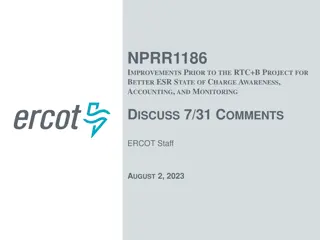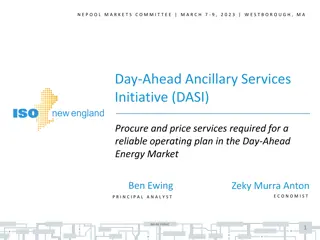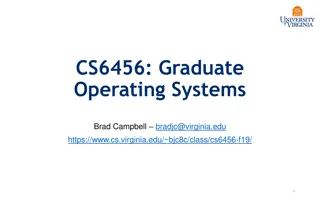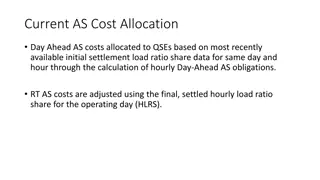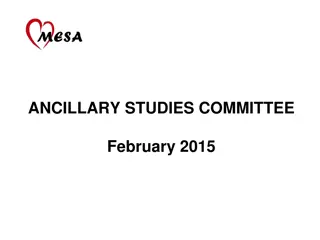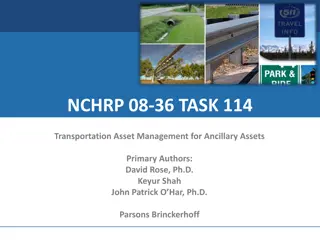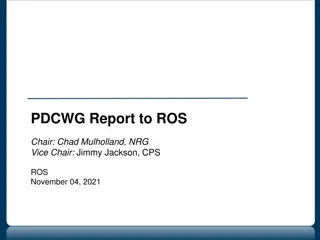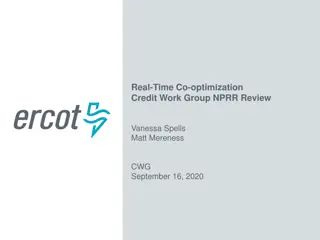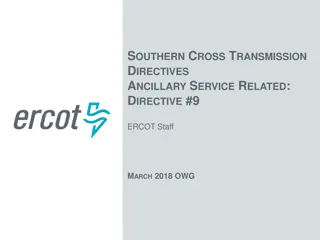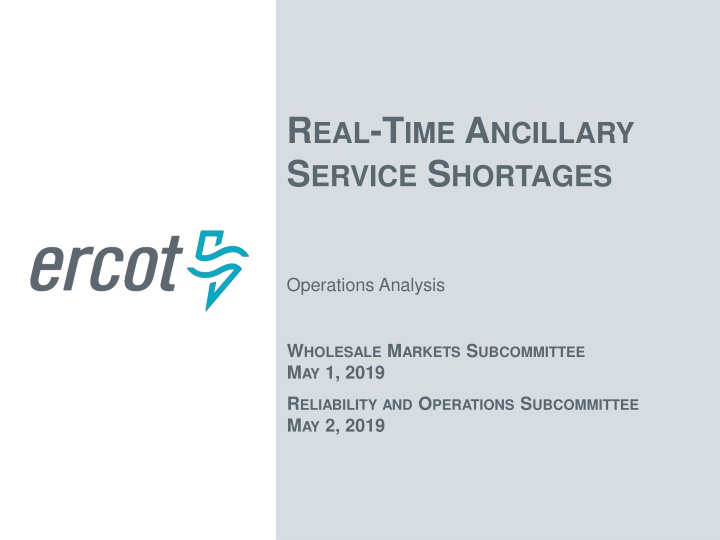
Addressing Real-Time Ancillary Service Shortages in Wholesale Markets
Learn about ERCOT's efforts to track and address Ancillary Service shortages in real-time, including the use of the Supplemental Ancillary Service Market mechanism. Explore the protocol language for Ancillary Services Capacity Monitor and Compliance Criteria set by ERCOT to ensure sufficient capacity for Ancillary Services.
Download Presentation

Please find below an Image/Link to download the presentation.
The content on the website is provided AS IS for your information and personal use only. It may not be sold, licensed, or shared on other websites without obtaining consent from the author. If you encounter any issues during the download, it is possible that the publisher has removed the file from their server.
You are allowed to download the files provided on this website for personal or commercial use, subject to the condition that they are used lawfully. All files are the property of their respective owners.
The content on the website is provided AS IS for your information and personal use only. It may not be sold, licensed, or shared on other websites without obtaining consent from the author.
E N D
Presentation Transcript
REAL-TIME ANCILLARY SERVICE SHORTAGES Operations Analysis WHOLESALE MARKETS SUBCOMMITTEE MAY 1, 2019 RELIABILITY AND OPERATIONS SUBCOMMITTEE MAY 2, 2019
Introduction ERCOT and the Independent Market Monitor (IMM) have noticed a consistent pattern of Ancillary Service (AS) shortages in Real-Time ERCOT has improved its internal process to better track these Real- Time AS shortages for post hoc analysis ERCOT can address AS shortages prior to the end of adjustment period with the Supplemental Ancillary Service Market (SASM) mechanism During the Operating Hour in Real-Time, Control Room Operators address AS shortages by manually contacting QSEs to resolve issues 2 PUBLIC 2
Protocol Language 6.5.7.5 Ancillary Services Capacity Monitor 2) Each QSE shall operate Resources providing Ancillary Service capacity to meet its obligations. If a QSE experiences temporary conditions where its total obligation for providing Ancillary Service cannot be met on the QSE s Resources, then the QSE may add additional capability from other Resources that it represents. It adds that capability by changing the Resource Status and updating the Ancillary Service Schedules and Ancillary Services Resource Responsibility of the affected Resources and notifying ERCOT under Section 6.4.9.1, Evaluation and Maintenance of Ancillary Service Capacity Sufficiency. If the QSE is unable to meet its total obligations to provide committed Ancillary Services capacity, the QSE shall notify ERCOT immediately of the expected duration of the QSE s inability to meet its obligations. ERCOT shall determine whether replacement Ancillary Services will be procured to account for the QSE s shortfall according to Section 6.4.9.1. 3 PUBLIC 3
Protocol Language 8.1.1.3 Ancillary Service Capacity Compliance Criteria 1) ERCOT shall provide each QSE representing Resources a capacity summary containing as a minimum the same general information required in Section 6.5.7.5, Ancillary Services Capacity Monitor, except specific to only the QSE. The summary shall be updated with calculations every ten seconds by ERCOT and then provided to the QSE every five minutes using the MIS Certified Area. 3) The QSE, within ten minutes of receiving the insufficient capacity notification from ERCOT, the QSE must: a) If due to a telemetry issue, correct the telemetered Ancillary Services Resource Responsibility to provide sufficient capacity; or b) Must provide both appropriate justification for not satisfying their Ancillary Service Obligation and a plan to correct the shortfall that is acceptable with the ERCOT operator. ERCOT shall report non-compliance of Ancillary Service capacity requirements to the Reliability Monitor for review. Note that, ERCOT has identified a report timing issue with the QSE AS Capacity Monitor for the first interval of the hour when responsibilities are compared to the previous hour s end of adjustment period responsibilities The report timing will change from 10 seconds prior to each 5-minute clock interval to run at the top of each 5-minute clock interval 4 PUBLIC 4
Real-Time AS Shortage Statistics Real-Time AS Shortages are calculated by averaging SCED telemetered responsibility with correct resource status codes compared to end of adjustment period AS Responsibility (which includes SASMs, AS Trades, etc.) Between April 1, 2018 and March 31, 2019: Average of 8 MW of total AS shortage each hour (0.15% of total AS requirement) Total QSE-AS-hours short as a percentage of total QSE-AS-hours: If 2 QSEs have 2 MW of REGUP and REGDN short for 2 hours, that is 8 QSE-AS-hours (total of ~964,000 QSE-AS-hours) 29,372 QSE-AS-hours short by 0.1 MW or more (3%) 10,175 QSE-AS-hours short by 1 MW or more (1%) 1,192 QSE-AS-hours short by 10 MW or more (0.1%) 1,243 reported Operator Log entries related to Ancillary Service shortages by the Resource, Real-Time, and Reliability Risk Desks 5 PUBLIC 5
Real-Time Max Hourly AS Shortage How to read graph: Each bar is a single day, where the max shortage per AS type is stacked Each AS type max shortage could come from a different hour in the day Surpluses within the same AS hour are not included 6 PUBLIC 6
Real-Time Max Hourly Net AS Shortage How to read graph: Each bar is a single day, where the max shortage per AS type is stacked Each AS type max shortage could come from a different hour in the day Surpluses within the same AS hour are included 7 PUBLIC 7
Real-Time Average Hourly AS Shortage How to read graph: Each bar is a single day, where the average shortage/surplus per AS type is stacked Surpluses within the same AS hour are included 8 PUBLIC 8
Common Reasons for Real-Time AS Shortages Some common reasons for the AS Shortages we noticed were QSE to QSE AS trade not submitted Telemetry errors such as incorrect responsibilities Incorrectly moving AS over the top of the hour or intra-hour Outage in which QSE is unable to move AS in time SASM executed but AS can t be procured for first couple of hours Incorrect resource status codes As a follow up ERCOT has sent 20+ Request For Information (RFIs) on April 4th to QSEs with Real-Time AS shortages greater than 10 MW for 3 consecutive SCED intervals 9 PUBLIC 9
Summary QSEs should ensure Resource Real-Time AS Responsibility and correct Resource Status Codes are telemetered according to Nodal Protocols Section 6.3.2 Activities for Real-Time Operations Communicate to ERCOT Resource changes to Ancillary Service Resource Responsibility via telemetry in the time window beginning 30 seconds prior to the five-minute clock interval and ending ten seconds prior to that five minute clock interval QSEs should ensure AS trades are properly submitted, even when moving AS between two QSEs related to the same Counterparty ERCOT will continue monitor Real-Time AS Shortages and will send out RFIs each month on an as needed basis 10 PUBLIC 10
APPENDIX PUBLIC 11 11
Resource Status Codes for Providing AS ERCOT EMS and SCED require both correct telemetered responsibilities and resource status code to properly deploy AS in Real-Time Resource status codes per AS type: Regulation Up: ONREG, ONOSREG, ONDSRREG, ONOPTOUT, ONRGL, FRRSUP Regulation Down: ONREG, ONOSREG, ONDSRREG, ONOPTOUT, ONRGL, FRRSDN Responsive Reserve Service: ONRUC, ONREG, ON, ONDSR, ONOSREG, ONDSRREG, ONEMR, ONRR, ONOPTOUT, ONRGL, ONCLR, ONRL Non-Spin Reserve Service: ONRUC, ONREG, ON, ONDSR, ONOS, ONOSREG, ONDSRREG, ONEMR, OFFNS, OFFQS, ONOPTOUT, ONRGL, ONCLR Note: Non-Spin can be in STARTUP or SHUTDOWN when being deployed 12 PUBLIC 12

